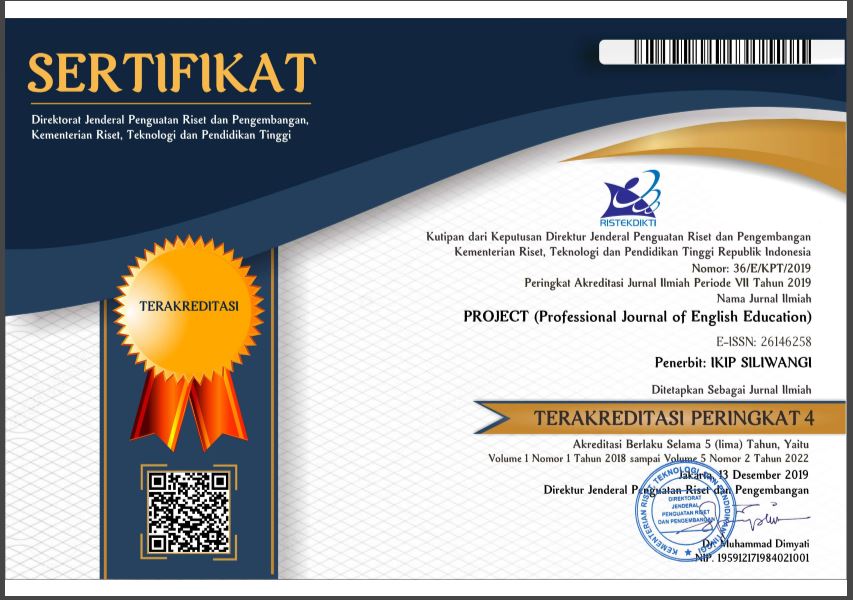IMPLEMENTING WORD WALL AS A MEDIA TO FACILITATE EFL STUDENTS IN LEARNING VOCABULARY
Abstract
The present study aimed to explore the implementation of word walls as a media to facilitate EFL (English as a Foreign Language) students in vocabulary learning. Conducted at a junior high school in Bekasi, this qualitative research utilized a case study design. Data were collected through observations and interviews. The results demonstrated that using word walls to support EFL students in learning vocabulary positively impacts their English language acquisition, particularly in vocabulary, which is often a significant challenge for learners of English. The use of word walls offers several advantages, such as enhancing students' comprehension of English, introducing them to new vocabulary, and promoting active participation in classroom activities. This method of vocabulary instruction was a novel approach for the students. After its implementation, student feedback was overwhelmingly positive. They became more engaged in class, found the material easier to grasp, and experienced vocabulary learning as more enjoyable. The findings suggest that word walls are effective visual aids that improve vocabulary retention and create a more interactive learning atmosphere. Students reinforced their understanding of new words through visual cues, which increased their engagement and participation in classroom discussions.
References
Adamovic, C., & Hedden, C. (1997). Word wall of basics. The Physics Teacher, 35(8), 451-451.
Cunningham, P. (2000). Phonics they use (3rd ed.). New York, NY: Longman.
Curtis, J. A. (2018). The effect of interactive word wall on English language learners’ academic vocabulary acquisition. The St Catherine University.
Darliani, Y., & Agustina, C. F. (2019). The implementation of word wall strategy in teaching writing descriptive text. JELA (Journal of English Language Teaching, Literature and Applied Linguistics), 1(2), 61-67.
Dhaifi, I., Setyosari, P., Widiati, U., & Ulfa, S. (2020). Optimizing Online Learning Resource to Improve Students' Autonomous Learning and Vocabulary Mastery through Word Wall Activities. PalArch's Journal of Archaeology of Egypt/Egyptology, 17(6), 8247-8266.
Harmon, J. M., Fraga, L. M., Martin, E., & Wood, K. D. (2013). Revitalizing word walls for high school English learners: Conventional and digital opportunities for learning new words. Georgia Journal of Literacy, 36(1), 20-28.
Harpiansi, H., & Astuti, F. K. (2019). Implementing The Total Physical Response Method With Word Wall Picture To Increase Deaf Students’vocabulary In The First Grade Of Smp Luar Biasa Negeri Martapura. Journal of English Educational Study (JEES), 2(1), 1-10.
Junizar, F., & Sudiyono, S. (2020). The Effectiveness Between Discovery Learning and Word Wall Methods in Improving Vocabulary At Seventh Grade Students. PROJECT (Professional Journal of English Education), 3(2), 180-186.
Kish, T. (2018). The Effectiveness of Word Walls on Various Groups of Students.
Marhamah, M., & Mulyadi, M. (2020). The effect of using word wall picture media and linguistic intelligence to enhance learning outcomes of English vocabularies. Journal of Educational and Social Research, 10(2), 134.
Miles, M. B., & Huberman, A. M. (1994). Qualitative data analysis: An expanded sourcebook. sage.
Nation, I. S., & Nation, I. S. P. (2001). Learning vocabulary in another language (Vol. 10). Cambridge: Cambridge University Press.
Olmos, C. (2009). An assessment of the vocabulary knowledge of students in the final year of secondary education. Is their vocabulary extensive enough? International Journal of English Studies, 9(3), 73-90.
Pradini, P. C., & Adnyayanti, N. L. P. E. (2022). Teaching English vocabulary to young learners with word wall application: An experimental study. Journal of Educational Study, 2(2), 187-196.
Qomariyah, S. S. A., & Nafisah, B. Z. (2020). Word Mapping in Students’ Vocabulary Mastery. Jo-ELT (Journal of English Language Teaching) Fakultas Pendidikan Bahasa & Seni Prodi Pendidikan Bahasa Inggris IKIP, 7(1), 31-40.
Rahman, A. W. (2018). The Role of Internal Memory to Enhance the Vocabulary By Using Word Wall. La Parole: Journal of Language Teaching and Pedagogy, 1(1), 44-52.
Shanahan, T. (2005). The National Reading Panel Report. Practical Advice for Teachers. Learning Point Associates/North Central Regional Educational Laboratory (NCREL).
Sinaga, H., Simamora, R., & Sari, A. S. P. (2018). Improving Students’vocabulary Mastery Through Word Walls Strategy To The Eighth Grade Students of Smp Swasta Karya Bhakti Medan. KAIROS, 2(1).
Sipayung, R. W. (2018). The effect of word wall strategy on students’ vocabulary achievement at SMP Negeri 5 Pematangsiantar in the academic year 2018/2019. Budapest International Research and Critics Institute (BIRCI-Journal): Humanities and Social Sciences, 1(3), 251-263.
Schmitt, N., & Schmitt, D. (2020). Vocabulary in language teaching. Cambridge University Press.
Sutherland, D. L. (2011). The effect of using interactive word walls to teach vocabulary to middle school students. Rowan University.
Triariani, R. (2020). The Effectiveness of Word Wall Media to Improve Students’ Vocabulary Mastery in Learning English at The Seventh Grade of SMPN 1 Siman Ponorogo (Doctoral dissertation, IAIN Ponorogo).
Umar, U., Rahman, R. A., Mandarsari, P., Mawarwati, M., & Amir, S. (2023). Using Word Wall Website As A Strategy To Improve Students’ Vocabulary Mastery. Journal on Education, 5(3), 9654-9661.
Utari, S., Syafitri, D., & Seli, S. (2020). Teaching Vocabulary Using Word Wall Media. EDULIA: English Education, Linguistic and Art Journal, 1(1), 33-39.
Wei, L. (2021). Teaching academic vocabulary to English language learners (ELLs). Theory and Practice in Language Studies, 11(12), 1507-1514.
Wessels, S. (2011). Promoting vocabulary learning for English learners. The Reading Teacher, 65(1), 46-50.
Zaen, F. N. W., Miftakh, F., & Purnamasari, I. (2022). The Use of Wordwall Media to Enrich Student's Vocabulary Size in EFL Class. Jurnal Ilmiah Wahana Pendidikan, 8(19), 127-136.
Downloads
Published
Issue
Section
License

This work is licensed under a Creative Commons Attribution-ShareAlike 4.0 International License.




